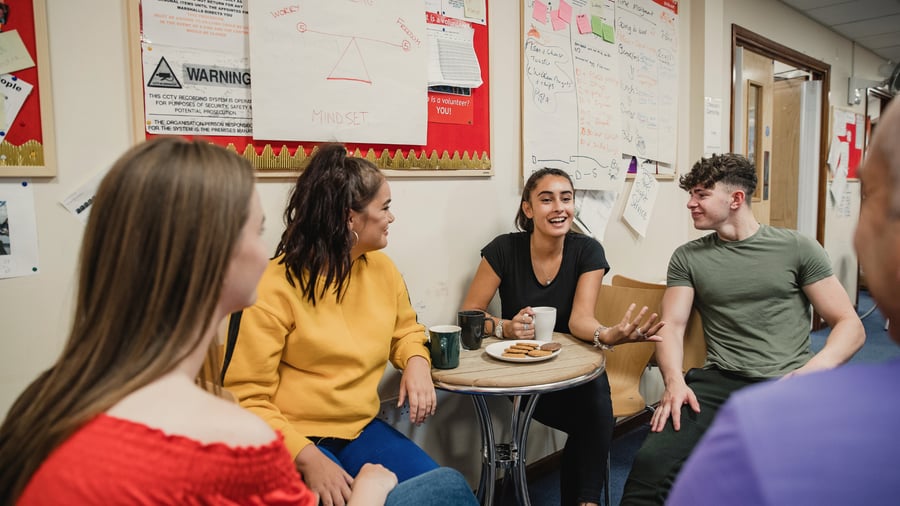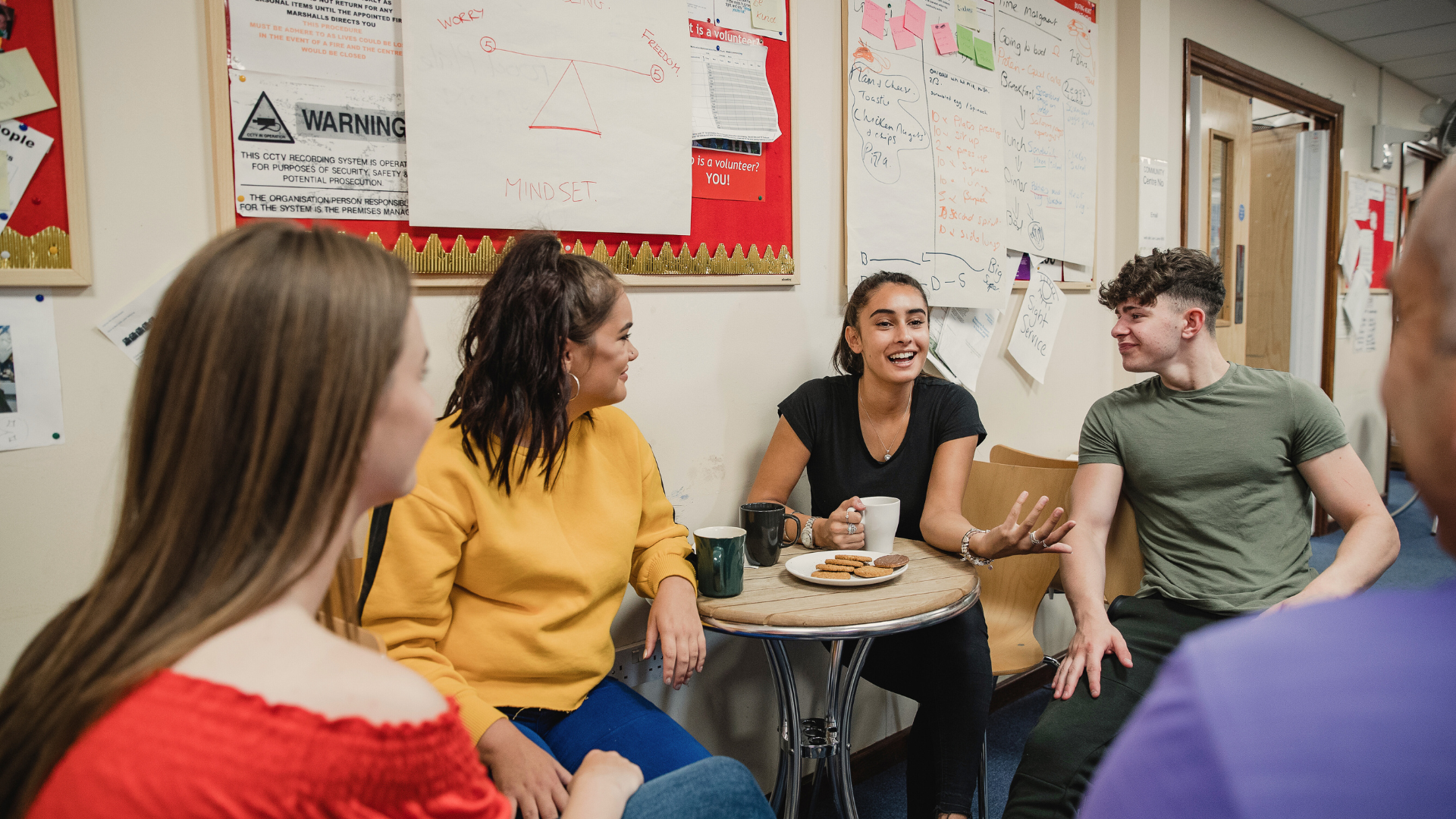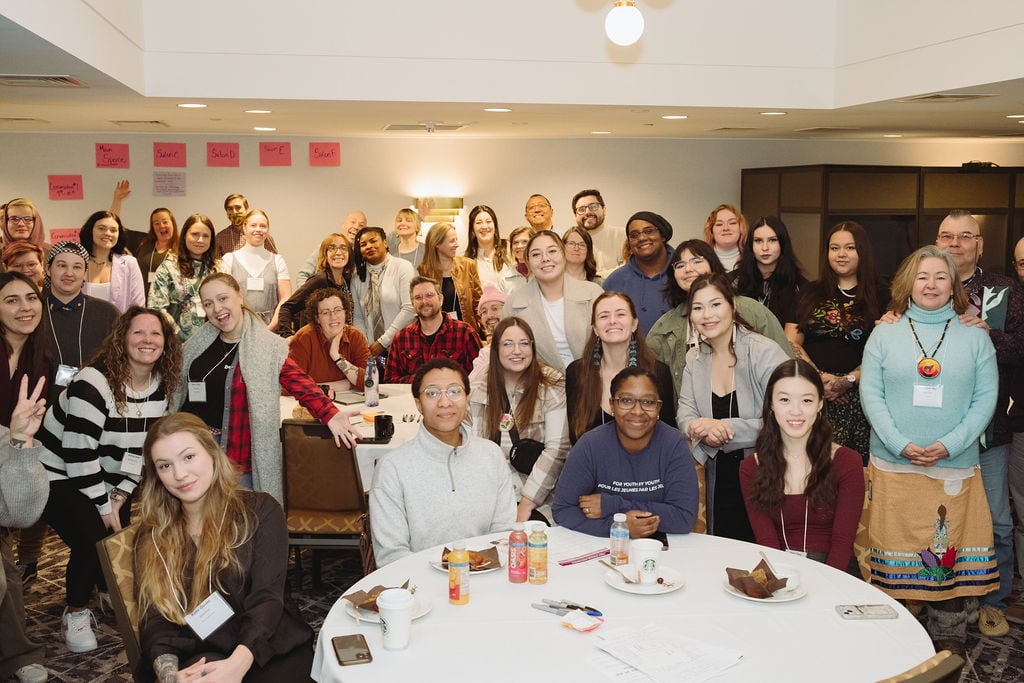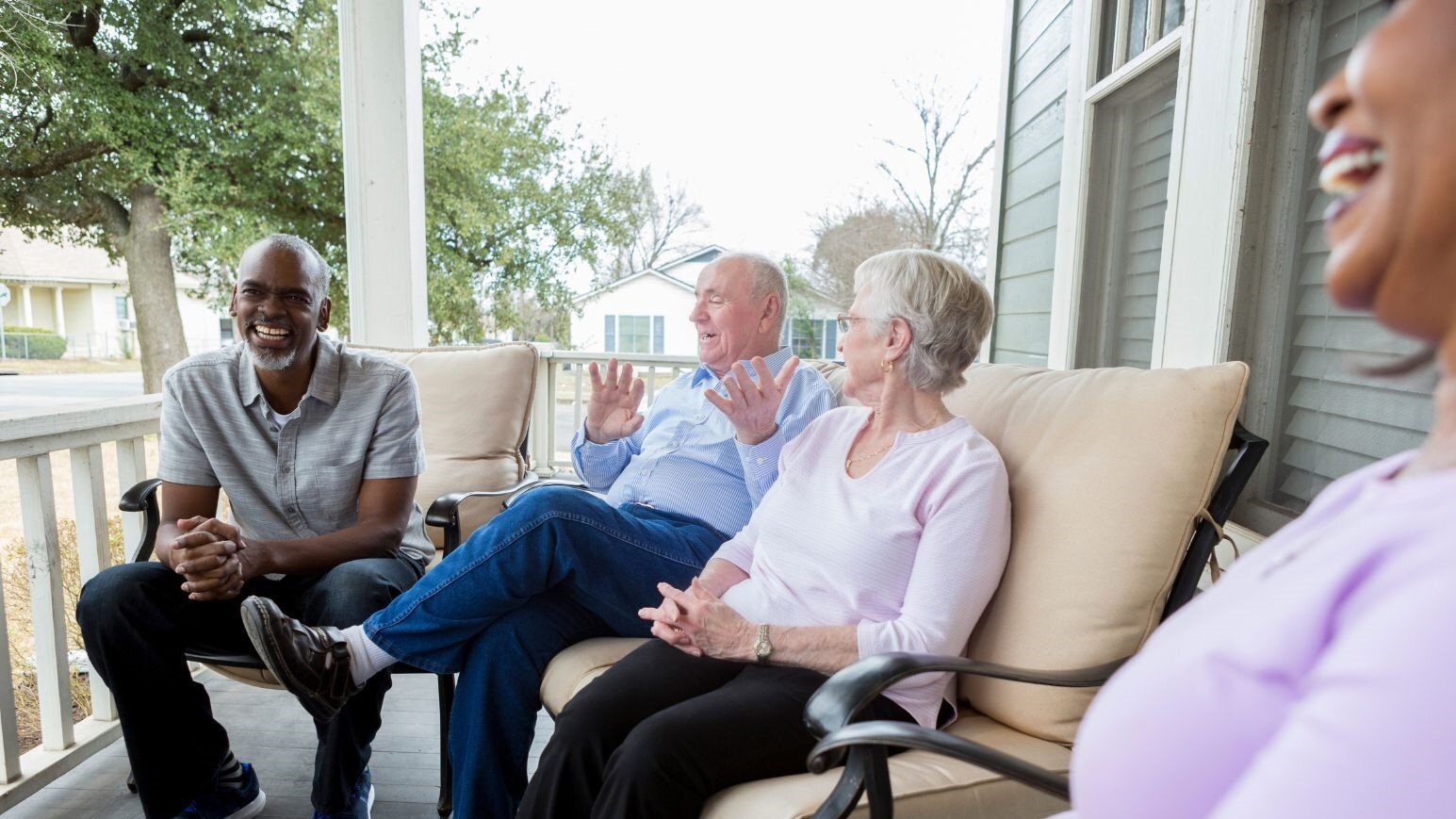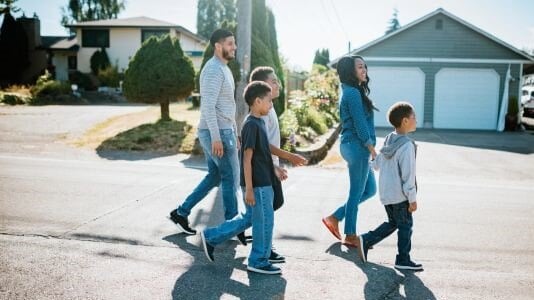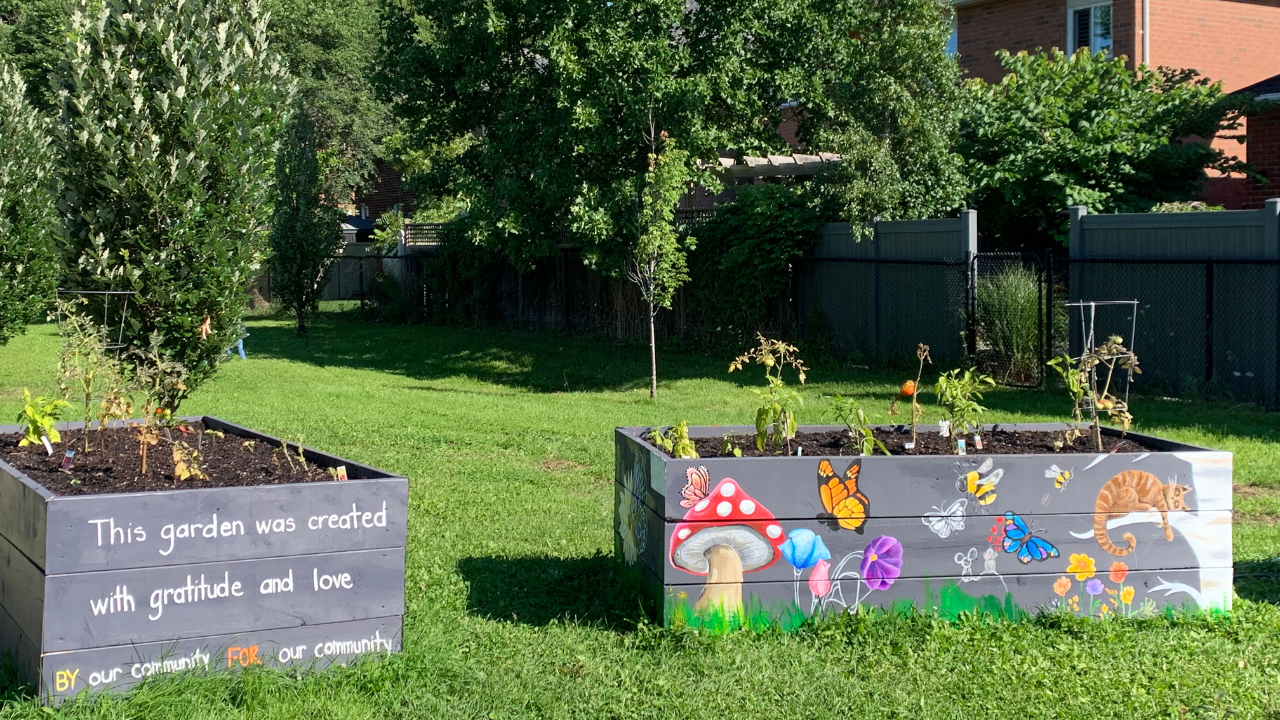Communities across Canada with a passion for multiple dimensions of health and well-being are turning to belonging. Recent studies reveal that a lack of positive social connection negatively impacts health at rates similar to smoking 15 packs of cigarettes a day, while also impacting housing prospects, employment, addiction, educational outcomes, mental health, and disaster preparedness. The potential of this work to turn the tide in sweeping public health goals means it’s time to develop and refine effective belonging strategies at every level of community development.
In this case study, we examine the Tri-Cities Intergenerational Belonging project, which intentionally brings together youth and seniors to foster positive relationships, and how a Collective Impact (CI) strategy guides their work. This initiative takes a tiered approach to accomplishing the following three goals:
-
Create a connection between existing intergenerational belonging interventions.
-
Increase opportunities for community members to lead and participate in intergenerational exchanges.
-
Promote belonging as a priority for municipal strategies, plans, and policies.
The Tri-Cities team, a vibrant participant in our 2025 Circle of Actions Cohort, is proving to be an energizing force within the Canada-wide movement for belonging. This Cohort, launched by the Tamarack Institute with support from the Samuel Family Foundation, brings together 13 teams from across Canada to develop plans and test interventions for belonging.
Through the Circle of Actions Cohort, the Tri-Cities team receives coaching from Tamarack’s Learning Centre on CI and other skills for change, including community engagement, collective leadership, and asset-based community development. One individual nominated by the Tri-Cities team participates in Pathways for Change, a leadership training program specifically for Cohort participants. The successes, challenges, and lessons learned from the Tri-Cities team and the other 12 Cohort participants directly inform the call for a Canada-wide Strategy, aiming to make belonging a policy priority for well-being and economic prosperity.
Why Collective Impact: Fostering Belonging in the Tri-Cities
Collective Impact, or CI, emerged to address complex, multilayered problems with many moving, continuously evolving parts. This strategy simultaneously reorganizes hierarchical, top-down systems to reflect equity in the way problems are identified and resolved. Belonging, as a dynamic experience requiring transformative systems change, matches well with Collective Impact.
|
About Tamarack's Work on BelongingAt the Tamarack Institute, we're dedicated to ending all forms of poverty, including relational poverty, by strengthening belonging in communities. Since 2016, our focus on connectedness has deepened, leading to a 2024 shift in our movement to make belonging a policy priority across Canada. The engagement of 70 collaboratives nationwide serves as a powerful testament: belonging is key to countering loneliness and polarization. |
The Tri-Cities team’s journey has revealed that Collective Impact (CI) can be a unifying force in both process and result. As they apply CI to their Intergenerational Belonging project with coaching from Tamarack, the team is bringing together representatives from organizations and collectives, with the intention of creating a sense of belonging among those most acutely at risk of isolation while nurturing trust, connection, and collaboration.
Through these efforts, the team is also bringing to life the vision of the call for a Canada-wide Strategy for Belonging, by advancing their own reflections on belonging as a policy priority, guided by local needs and aspirations.
The Tri-Cities community is made up of three municipalities and two villages and has a population of over 240,000, with 44.3% of its neighbours and residents born outside of Canada. A CI framework has thus far allowed them to collaborate with different teams in ways that touch on many layers of public health as it relates to belonging in their diverse, culturally rich environment. In the following section, we will walk through the five conditions of CI, how Tri-Cities has adopted this approach, and what we’ve learned so far from their experience.
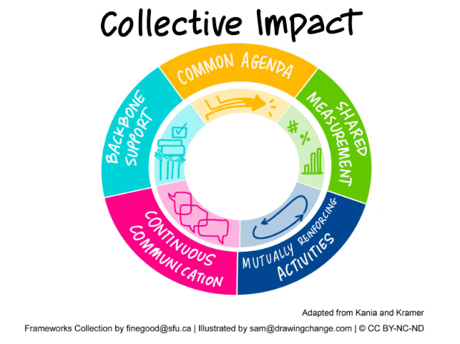
Applying Collective Impact in the Tri-Cities
The Tri-Cities team is part of the Tri-Cities Healthier Communities Partnership (HCP). The HCP initiative is Fraser Health’s commitment to working with municipalities and community organizations to create healthy environments where residents live, work, learn, and play. In 2008, in recognition of the need for a healthy community approach, Fraser Health began working with municipal leaders across the region to establish these formal partnerships, which were later mandated by the BC government in 2012.1 In the Tri-Cities, municipal councillors and staff, the school district, community committees and coalitions, library, the Local Immigration Partnership, Fraser Health and other partners work across sectors toward promoting health and well-being in their community.
In partnership with the HCP Table, the Tri-Cities team is igniting action around the five conditions for CI:
1. Establishing a Common Agenda
One of the first pillars of Collective Impact, not to mention one surprisingly easy to overlook, is determining what exactly the community prioritizes and wishes to change. In 2024, Tri-Cities HCP launched a voting process of member organizations and identified mental wellness and social connectedness as pressing priorities in which they could take immediate action and begin defining a shared vision. Regional community health data have shown that older adults have higher rates of social isolation compared to other age groups, and local community survey data on child and youth social competence, social connectedness, and general well-being indicate areas for improvement.
This informed the vision for a project that would connect older adults with children and youth in relationships that are reciprocal, protective, and have lasting impacts on community wellness. While barriers to belonging and civic participation exist for many, they are often much more extensive and severe for racialized individuals, members of Indigenous communities, seniors, people living with diverse abilities, and other equity-denied groups. To address historic and ongoing harm, the Tri-Cities team actively embeds equity considerations in the project’s implementation, with the aim of elevating the voices and needs of equity-denied groups.
They also found a need for sustainable and impactful programs; increased participation of older adults, youth, and children in community life; and policy shifts that recognize belonging as a foundation for health, well-being, and economic prosperity. They believe strongly in collective work that engages multiple community partners working together to uplift each other’s goals and extend the impact of felt belonging within the community, none of which can be done without backbone support.
2. Backbone Support
The Tri-Cities HCP forms the often overlooked yet essential component of a Collective Impact initiative. The HCP is a formalized partnership between organizations that meets quarterly, sets a common agenda, and maintains a network of engaged and diverse partners to enact the Table’s objectives. For this project, representatives from Fraser Health, the Tri-Cities Local Immigration Partnership, and the Tri-Cities Literacy Committee provide substantial backbone support and serve as project co-leads. The co-leads dedicate consistent time and focus to support the core work, guide the project’s vision over the long term, and offer unique insights into belonging. The backbone role is not about expertise or top-down authority; it’s about facilitating continuous communication and grounding a dynamic process with a reliable central anchor. The Tamarack Institute further supports these efforts with coaching, cohort membership, networking, and regular check-ins, affirming best practices in CI strategy.
From the perspective of Abigail, Shaina, and Amy, their three-way collaboration itself feels like Collective Impact in action.
“In my experience, one of the best ways to create and deepen relationships is to work with others on something that you care about. Our project is creating meaningful opportunities for our group members to contribute, learn, move through conflict, and experience the benefits – and magic – of reciprocity. And that’s also what the project is hoping to create in our communities more broadly. I think when the process reflects the desired outcome, that’s a good sign.”
Shaina
"This collaborative project has enabled me to learn from others and to understand the different community priorities and perspectives. Most importantly, it has allowed for meaningful dialogue and aligned our activities toward common goals. It is enriching to work with folks who are dedicated and committed toward seeing impactful change in the community.”
Abigail
“Our group members have developed their own sense of community during the project. Their passion to use their learnings to benefit the entire community through a cooperative process is what will move this project forward to bring a sense of belonging to the Tri-Cities.”
Amy
3. Continuous Communication
One of the major challenges to be addressed is power distribution. Belonging compels us to rethink leadership and who holds power. The CI principle of continuous communication among diverse community groups offers an effective framework for this. Under this pillar, CI engages multiple community sectors in ongoing dialogues, fostering mutual relationships and collaboration around a common agenda. In this area, the Tri-Cities initiative had a head start because of the long-standing HCP Table.
By bringing together people not typically in conversation, Tri-Cities is actively working towards a more integrated community. This process reimagines the distribution of power and the division of labour in improving community well-being, simultaneously repositioning those involved in power-holding institutions as equitably powerful members of the broader community. This shift catalyzes community-led interventions by prioritizing partnership with pre-existing grassroots initiatives over competition or acquisition. They work together with their region to identify and support “third spaces”— areas that connect people with tangible resources and intentional social support.
4. Mutually Reinforcing Activities
This fourth pillar of collective impact brings together otherwise separate community members and organizations dedicated to a common agenda. This approach allows multiple sectors and communities to contribute their unique strengths towards shared goals, greatly expanding the range of possible effective solutions while simultaneously fostering new relationships, trust, and social cohesion.
The Tri-Cities team complements their work with Asset-Based Community Development (ABCD), specifically asset-mapping. This approach provides clear guidance for identifying and mobilizing people’s gifts, interests, and strengths, and connecting them to a shared purpose. By integrating ABCD with their CI strategy, Tri-Cities celebrates existing programs, avoids duplication, and fosters collaboration over competition. Below are examples of programs that have worked with and inspired the Tri-Cities team:
-
The Holiday Hello Program: Students write and deliver holiday cards to seniors living in assisted living homes. In 2024, 3000 cards were delivered to 735 seniors. Already a functioning partnership between the library and schools, the Tri-Cities group is exploring options to reach even more isolated people, such as folks receiving medical care in their homes, by partnering with the health sector.
-
Community Consultation with City of Port Moody: Tri-Cities Local Immigration Partnership is collaborating with the City of Port Moody on an arts-based community engagement event to talk about intergenerational belonging among seniors. This takes place during the City’s Seniors Try-It Week. This collaboration enables the Local Immigration Partnership to reach seniors who may not be aware of settlement services in the community, while also promoting the City’s event to their network.
-
Real Acts of Caring Project, or RAC, inspires students (grades 3 –9) to engage in intentional acts of kindness. During the pandemic, the students created the Intergenerational Integrities program to reach seniors who were isolated by coming together in online meetings to share their stories across generations. RAC also increased momentum for civic engagement, with students wanting to do more for other people and the environment. The Tri-Cities group is exploring how to support and expand this program, which has shown an increased sense of belonging, reduced bullying, and decreased depression and anxiety among participants.
5. Shared Measurement
The final and sometimes most challenging CI component is shared measurement. This requires clear definitions of what is being measured, how, and ongoing means of shared, equitable, and participatory data collection. As belonging is a nascent field, measuring progress within communities presents a particularly complex and exciting new challenge, with the measurable indicators of belonging being subjective and possibly varying from one community to the next.
The Tri-Cities partnership considers local data on social connectedness and equity crucial for effective municipal strategies. As evidence-based approaches for promoting belonging at the city level emerge, they will be openly shared and regularly reported back to the Healthy Communities Partnership table. Tri-Cities is currently collaborating with community partners and the Tamarack Institute to develop and implement a collectively defined shared measurement strategy, navigating the early-stage complexities of this process.
Collective Impact for Belonging: Lessons from the Tri-Cities Team
The members of the Tri-Cities backbone organization are in a process of learning and discovery when it comes to CI and belonging. Thanks to their generosity, clarity, and investment, we have been able to learn alongside them, uncovering powerful insights even at these early stages. Here are some takeaways we’ve found together thus far.
The following reflections have emerged from the CI journey of the Tri-Cities team as a 2025 Circle of Actions Cohort participant:
-
Building on Existing Strengths: The Tri-Cities case highlights the advantage of leveraging existing structures. The HCP Table was running before the Tri-Cities Intergenerational Belonging Project began, giving them an immediate foundation for continuous communication, effectively jumpstarting the CI project. If similar collaborative platforms exist in your community, consider partnering with them to accelerate groundwork and foster collaboration.
-
The Power of Dedicated Backbone Support: Sustainable initiatives rely on consistent backbone support, especially as other participants’ involvement may vary. Identifying and nurturing these dedicated individuals and organizations is crucial. The alliance between Fraser Health, the Tri-Cities Local Immigration Partnership, and the Tri-Cities Literacy Committee exemplifies this, demonstrating that an effective backbone organization can emerge from otherwise unlikely collaborations facilitated by a CI strategy. Organizations do not need pre-existing connections to excel in this role.
-
Nurturing Community-Led Leadership: Reaffirming members of the community who are not involved in recognized institutions that they can take on leadership roles can take time and strategic reframing. This involves acknowledging diverse capacities and desires, along with flexible approaches to power and labour distribution. It’s a journey of affirming latent leadership within the community.
-
Navigating Shared Measurement: Developing a shared measurement strategy seems to be among the most challenging aspects to navigate, both in establishing what will be used as a reliable measure, how they will know if they are measuring the outcome they want to be measuring, and how that measurement will take shape, especially as desired outcomes themselves can be dynamic and moving objects.
-
The Art of Letting Go: Collective Impact inherently involves letting go–whether it’s releasing treasured partnerships when their season ends or relinquishing control as the initiative becomes a shared endeavour.
Despite the complexities and early stages, the work in Tri-Cities shows exciting signs of positive change.
Conclusion
When communities come together to meaningfully cultivate belonging at multiple scales, they can subjectively and objectively transform people’s lives in deeply meaningful ways. While there can be many barriers to a holistic belonging strategy, the Tri-Cities Intergenerational Project offers an example of how using Collective Impact constructively transforms systems as they are today to ones that reflect and facilitate shared power, equitable division of labour, and mutual support. This strategy and approach to partnership can significantly alter hierarchical, competitive, isolating systemic structure to those that generate and sustain belonging to the benefit of individual and community health. These partnerships can simultaneously foster deep, meaningful relationships while expanding the reach, scope, and diversity of belonging solutions throughout a community.
Tri-Cities emphasizes collaboration in its approach, actively seeking out programs that already exist, looking for ways to support and connect them, and to center equity-denied members of the community in consistent conversation with those who have been given more access and means of exercising control. They’ve identified community-level leaders and programs that are already making a meaningful impact in areas of belonging, as well as the most up-to-date policy considerations and thinking at a municipal level when it comes to changing belonging and loneliness outcomes for communities. By continuing to learn with and from members of their community and moving in the direction of fully integrated community action, they are co-discovering a way forward for municipalities, communities, and residents who want to see belonging become an actionable public health priority wherever they call home.
Dive Deeper
-
Learn more about Seeds of Transformation, Tamarack’s framework for centring equity, anti-racism, and reconciliation into our Networks for Change.
-
Explore our Collective Impact Toolkit.
-
Take a look at the Strategy for Belonging report, sign the belonging pledge, and join us in making belonging a policy priority in Canada.
-
Try out our Changemaker Self-Assessment and learn more about the skills needed to make community change.

